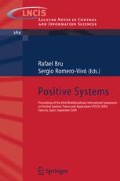Abstract
Positivity of states and parameters in dynamic models for chemical reaction networks are exploited by Chemical Reaction Network Theory (CRNT) to predict the potential for multistationarity of ‘regular’ networks without knowledge of parameter values. Especially for biochemical systems, however, CRNT’s large application potential cannot be realized because most realistic networks are degenerate in the sense of CRNT. Here, we show how degenerate networks can be regularized such that the theorems and algorithms of CRNT apply. We employ the method in a case study for a bacterial reaction network of moderate size.
Access this chapter
Tax calculation will be finalised at checkout
Purchases are for personal use only
Preview
Unable to display preview. Download preview PDF.
References
Conradi, C., Flockerzi, D., Raisch, J., Stelling, J.: Subnetwork analysis reveals dynamic features of complex (bio)chemical networks. Proc. Natl. Acad. Sci. 104(49), 19175–19180 (2007)
Doyle, F.J., Stelling, J.: Systems interface biology. J. R. Soc. Interface 10(3), 603–616 (2006)
Feinberg, M.: Chemical reaction network structure and the stability of complex isothermal reactors – I. The deficiency zero and deficiency one theorems. Chemical Engineering Science 42(10), 2229–2268 (1987)
Feinberg, M.: Chemical reaction network structure and the stability of complex isothermal reactors – II. Multiple steady states for networks of deficiency one. Chemical Engineering Science 43(1), 1–25 (1988)
Flockerzi, D., Conradi, C.: Subnetwork analysis for multistationarity in mass action kinetics. Journal of Physics: Conference Series 138, 36 pages (012006) (2008)
Gatermann, K., Wolfrum, M.: Bernstein’s second theorem and Viro’s method for sparse polynomial systems in chemistry. Advances in Applied Mathematics 34(2), 252–294 (2005)
Gunawardena, J.: Chemical reaction network theory for in-silico biologists. Bauer Center for Genomics Research (2003)
Stelling, J., Sauer, U., Szallasi, Z., Doyle, F.J., Doyle, J.: Robustness of cellular functions. Cell 118(6), 675–685 (2004)
Author information
Authors and Affiliations
Editor information
Editors and Affiliations
Rights and permissions
Copyright information
© 2009 Springer-Verlag Berlin Heidelberg
About this paper
Cite this paper
Uhr, M., Kaltenbach, HM., Conradi, C., Stelling, J. (2009). Analysis of Degenerate Chemical Reaction Networks. In: Bru, R., Romero-Vivó, S. (eds) Positive Systems. Lecture Notes in Control and Information Sciences, vol 389. Springer, Berlin, Heidelberg. https://doi.org/10.1007/978-3-642-02894-6_16
Download citation
DOI: https://doi.org/10.1007/978-3-642-02894-6_16
Publisher Name: Springer, Berlin, Heidelberg
Print ISBN: 978-3-642-02893-9
Online ISBN: 978-3-642-02894-6
eBook Packages: EngineeringEngineering (R0)

